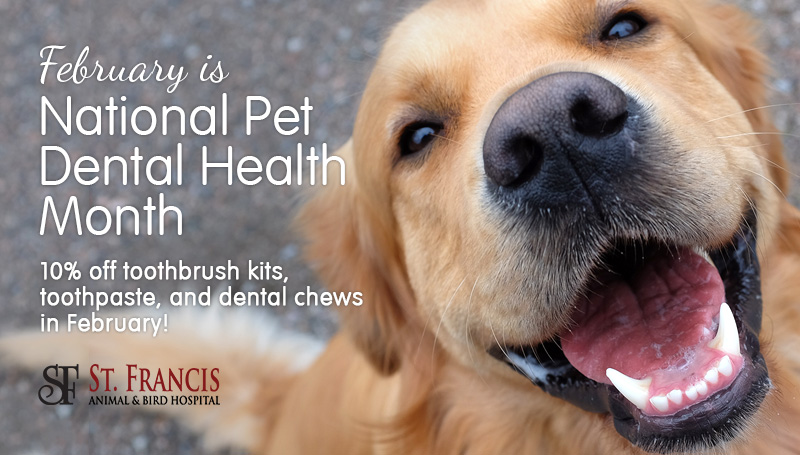Are you knocked over by Bailey’s bad breath? Does Max have a yellow film on his teeth? Are Matilda’s gums red? Dental disease is one of the most common diseases that we treat in dogs and cats, and with regular tooth brushing, we can help reduce the risks of this disease.
The goal of tooth brushing is to slow the progression of tartar accumulation on the teeth and reduce the frequency of professional dental cleanings for your pet.
As you begin working on home dental care with your pet, it is important to keep the activity very positive. Provide praise and positive reinforcement so this becomes a fun activity for both of you. Keep in mind that it is important to be safe — if your pet growls or bites when you attempt brushing, this may not be safe for you to do.
Tips:
1) If you have a puppy or kitten, start early! Of course, it’s never too late to start. Begin to work on handling your pet’s mouth by first massaging the outside of the cheeks and lips, then start focusing on the outer surface of the teeth and gums. You do not need to pry the mouth open – you just need to focus your care on the outside surface. If your pet shies away from handling the mouth, take baby steps to get him or her used to this type of touch.
2) Place your pet dental supplies in a container in the bathroom where you brush your teeth. Be sure to place treats for motivation or food kibble in the container as well. The initial goal is to train your pet that every time you brush your teeth, they will receive a reward. Call your pet into the bathroom when you brush your teeth and reward him or her with a treat or piece of food.
3) Once your pet is comfortable with basic handling, begin gently rubbing the flavored pet toothpaste on the outside of the teeth. You do not need to open the mouth, but rather slide your finger along the inside of the cheek and the outside of the teeth. Be sure to keep this positive and use an excited tone of voice to praise your pet. If your pet resists, work on offering the paste as a treat that they can lick from your finger. Continue these steps until your pet is comfortable.
4) Once you’ve mastered these steps, try switching to a finger brush or soft toothbrush with the toothpaste applied to it. You can now try short intervals of brushing, but remember to keep the initial sessions short and provide praise. You can slowly increase the amount of time you are able to brush the teeth without your pet losing patience. Make sure to change your toothbrush every 3-4 months and always use a new brush after a professional dental cleaning.
Daily brushing would be excellent, if possible, but you should try to brush at least 2-3 times per week. Remember, the more often you brush, the more successful you will be at maintaining healthy teeth – and fresh breath!
February is National Pet Dental Health Month – Receive 10% off toothbrush kits, toothpaste, and dental chews in February!
Image credit: Sari Juurinen | iStock/Getty Images Plus

